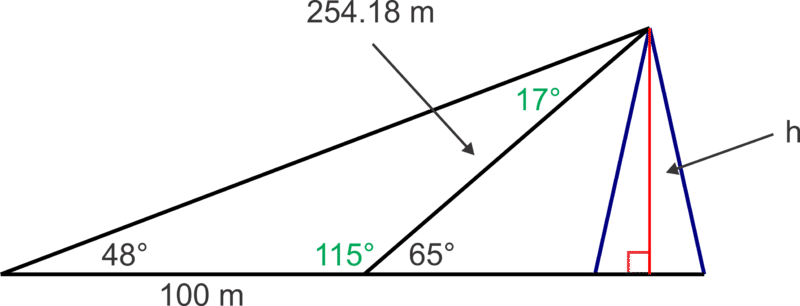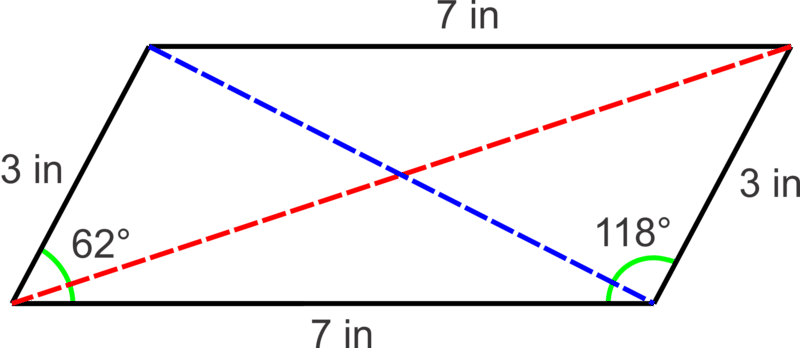4.2.4: Heron's Formula
- Page ID
- 4170
Area formula based on lengths of sides of a triangle and half its perimeter.
Sarine draws a triangle and measures its sides as 2 inches, 5 inches and 6 inches. What is the area of her triangle?
Heron's Formula
Heron’s Formula, named after Hero of Alexandria 2000 years ago, can be used to find the area of a triangle given the three side lengths. The formula requires the semi-perimeter, \(s\), or \(\dfrac{1}{2}(a+b+c)\), where \(a\), \(b\) and \(c\) are the lengths of the sides of the triangle.
Heron’s Formula:
\(\text{Area}=\sqrt{s(s−a)(s−b)(s−c)}\)
Let's use Heron’s formula to find the area of a triangle with side lengths 13 cm, 16 cm and 23 cm.
First, find the semi-perimeter or \(s\): \(s=\dfrac{1}{2}(13+16+23)=26\). Next, substitute our values into the formula as shown and evaluate:
\(A=\sqrt{26(26−13)(26−16)(26−23)}=\sqrt{26(13)(10)(3)}=\sqrt{10140}\approx 101 \text{ cm}^2\)
Now, let's answer the following questions.
- Alena is planning a garden in her yard. She is using three pieces of wood as a border. If the pieces of wood have lengths 4 ft, 6 ft and 3 ft, what is the area of her garden?
The garden will be triangular with side lengths 4 ft, 6 ft and 3 ft. Find the semi-perimeter and then use Heron’s formula to find the area.
\(\begin{aligned} s&=\dfrac{1}{2}(4+6+3)=\dfrac{13}{2} \\ A&=\sqrt{\dfrac{13}{2}\left(\dfrac{13}{2}−4\right)\left(\dfrac{13}{2}−6\right)\left(\dfrac{13}{2}−3\right)}=\sqrt{\dfrac{13}{2} \left(\dfrac{5}{2}\right) \left(\dfrac{1}{2}\right)\left(\dfrac{7}{2}\right)}=\sqrt{\dfrac{455}{16}} \approx 28 \text{ ft}^2 \end{aligned}\)
- Caroline wants to measure the height of a radio tower. From some distance away from the tower, the angle of elevation from her spot to the top of the tower is \(65^{\circ} \). Caroline walks 100 m further away from the tower and measures the angle of elevation to the top of tower to be \(48^{\circ} \). How tall is the tower?

First, make a diagram to illustrate the situation.
We can use angle properties (linear pair and triangle sum) to find the angles shown in green in the diagram.
\(180^{\circ} −65^{\circ} =115^{\circ} \) and \(180^{\circ} −48^{\circ} −115^{\circ} =17^{\circ}\)
Next, we can use the Law of Sines in the obtuse triangle to find the hypotenuse in the right triangle:
\(\begin{aligned} \dfrac{\sin 17^{\circ} }{100} =\dfrac{\sin 48^{\circ} }{x} \\ x=\dfrac{100 \sin 48^{\circ}}{ \sin 17^{\circ} } \approx 254.18 \end{aligned}\)
Finally we can use the sine ratio in the right triangle to find the height of the tower:
\(\sin 65^{\circ} =\dfrac{h}{254.18}\), \(h=254.18\sin 65^{\circ} \approx 230.37 \text{ m}\)
Earlier, you were asked to find the area of the triangle with sides of length 2 inches, 5 inches, and 6 inches.
Solution
First, find the semi-perimeter or s: \(s=\dfrac{1}{2}(2+5+6)=6.5\). Next, substitute our values into Heron's formula and evaluate:
\(A=\sqrt{6.5(6.5−2)(6.5−5)(6.5−6)}=\sqrt{6.5(4.5)(1.5)(0.5)}=\sqrt{21.94} \approx 4.7 \text{ in.}^2\)
Use the most appropriate rule or formula (Law of Sines, Law of Cosines, area formula with sine or Heron’s formula) to answer the following questions.
Find the area of a triangle with side lengths 50 m, 45 m and 25 m.
Solution
Heron’s Formula:
\(s=\dfrac{1}{2} (50+45+25)=60\), \(A=\sqrt{60(60−50)(60−45)(60−25)} \approx 561 \text{ m}^2\).
Matthew is planning to fertilize his grass. Each bag of fertilizer claims to cover 500 sq ft of grass. His property of land is approximately in the shape of a triangle. He measures two sides of his yard to be 75 ft and 100 ft and the angle between them is \(72^{\circ} \). How many bags of fertilizer must he buy?
Solution
Area formula with sine: \(\dfrac{1}{2} (75)(100)\sin 72^{\circ} \approx 3566 \text{ ft }^2\), Number of bags \(\dfrac{3566}{500} \approx 7.132\approx 8 \text{ bags}\). We round up because 7 bags is not quite enough.
A pair of adjacent sides in a parallelogram are 3 in and 7 in and the angle between them is \(62^{\circ} \), find the length of the diagonals.

Solution
Law of Cosines to find the blue diagonal:
\(\begin{aligned} c^2&=3^2+7^2−2(3)(7)\cos 62^{\circ} \\ c&=\sqrt{38.28}\approx 6.19 \end{aligned}\)
So, 6.19 in
To find the green diagonal we can use the Law of Cosines with the adjacent angle: \(180^{\circ} −62^{\circ} −118^{\circ} \):
\(\begin{aligned} c^2 &=7^2+3^2−2(7)(3)\cos 118^{\circ} \\ c&=\sqrt{77.72} \approx 8.82 \end{aligned}\)
So, 8.82 in
Review
Use the Law of Sines, Law of Cosine, area of triangle with sine or Heron’s Formula to solve the real world application problems.
- Two observers, Rachel and Luis, are standing on the shore, 0.5 miles apart. They each measure the angle between the shoreline and a sailboat out on the water at the same time. If Rachel’s angle is \(63^{\circ} \) and Luis’ angle is \(56^{\circ} \), find the distance between Luis and the sailboat to the nearest hundredth of a mile.
- Two pedestrians walk from opposite ends of a city block to a point on the other side of the street. The angle formed by their paths is \(125^{\circ} \). One pedestrian walks 300 ft and the other walks 320 ft. How long is the city block to the nearest foot?
- Two sides and the included angle of a parallelogram have measures 3.2 cm, 4.8 cm and \(54.3^{\circ} \) respectively. Find the lengths of the diagonals to the nearest tenth of a centimeter.
- A bridge is supported by triangular braces. If the sides of each brace have lengths 63 ft, 46 ft and 40 ft, find the measure of the largest angle to the nearest degree.
- Find the triangular area, to the nearest square meter, enclosed by three pieces of fencing 123 m, 150 m and 155 m long.
- Find the area, to the nearest square inch, of a parallelogram with sides of length 12 in and 15 in and included angle of \(78^{\circ} \).
- A person at point \(A\) looks due east and spots a UFO with an angle of elevation of \(40^{\circ} \). At the same time, another person, 1 mi due west of A looks due east and sights the same UFO with an angle of elevation of \(25^{\circ} \). Find the distance between A and the UFO. How far is the UFO above the ground? Give answers to the nearest hundredth of a mile.
- Find the area of a triangular playground, to the nearest square meter, with sides of length 10 m, 15 m and 16 m.
- A yard is bounded on two sides with fences of length 80 ft and 60 ft. If these fences meet at a \(75^{\circ} \) angle, how many feet of fencing are required to completely enclosed a triangular region?
- When a boy stands on the bank of a river and looks across to the other bank, the angle of depression is \(12^{\circ} \). If he climbs to the top of a 10 ft tree and looks across to other bank, the angle of depression is \(15^{\circ} \). What is the distance from the first position of the boy to the other bank of the river? How wide is the river? Give your answers to the nearest foot.
Answers for Review Problems
To see the Review answers, open this PDF file and look for section 13.17.

